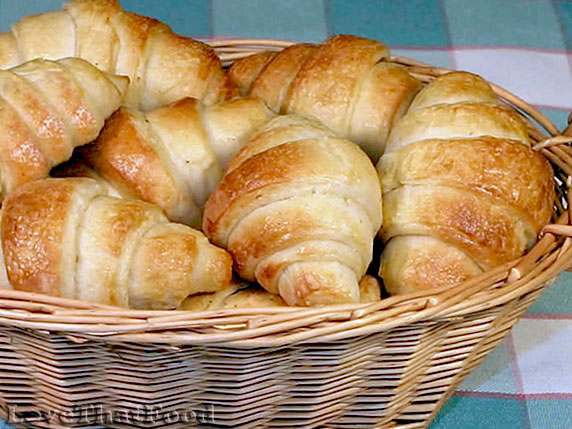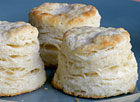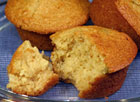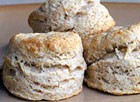Croissants

Yield: 40 croissants
Cook Time: 12-15 minutes
Tips: If accessible, use a granite or marble work surface and marble roller pin to help dough maintain a cool temperature. See recipe and recipe description for croissant variations.
Suggestion: Serve with butter and/or jam and preserves or use as bread for miniature sandwich appetizers.
Croissants are light, flaky and buttery crescent-shaped French pastries that are wonderful fresh from the oven, toasted or served at room temperature. Croissants (also sometimes called
crescents or crescent rolls) an be made in small, medium and large sizes and can be served in a variety of ways. Small croissants make wonderful miniature pastry appetizers, medium-sized croissants are great as a bread side dish for any meal, while large sizes can be used as a flaky bread for sandwiches. Croissants also make an easy and quick breakfast, toasted or warmed and topped with butter and/or jam or preserves.
Croissants can also be filled with chocolate, almond paste, pralines or other ingredients to create a delicious dessert or sweet breakfast. Other fillings such as ham and cheese, feta cheese and spinach or any variety of cheese can be used to create a warm and delicious filled croissant, and when made in small sizes make fabulous appetizers. Photo above shows croissants made into 4-inch lengths, but you can make any size croissants you prefer (recipe discusses how to make different sizes).
Recipe▼
Ingredients
- 1 1/2 cups butter
- 1/4 cup flour
- 2 packages or 2 tablespoons yeast
- 1/2 cup warm water
- 3/4 cup milk, scalded
- 1/4 cup sugar
- 1 teaspoon salt
- 1 egg, beaten
- 3 1/2 - 4 cups all-purpose flour
- 1 egg yolk
- 1 tablespoon milk
Directions
In a small mixing bowl, cream together butter and 1/4 cup flour. Once thoroughly blended, place between 2 sheets of wax paper and flatten with a rolling pin to a 12 x 6-inch rectangle. Place in refrigerator and chill for 1 hour or longer.
Add warm water to a small bowl, then add yeast and stir until blended. Set aside. In a medium mixing bowl, stir together scalded milk, sugar and salt. Allow to cool to lukewarm. Add yeast and egg to milk mixture and stir to combine. Add 3 1/2 cups flour and stir, then add up to 1/2 cup more of flour as needed to make a soft dough that does not stick to your hands.
Transfer dough to a work surface lightly sprinkled with flour. (Note: If accessible, working on a marble or granite surface and using a marble rolling pin is helpful because it helps to keep the dough at a cool temperature.) Knead dough for 5 minutes, sprinkling small amounts of flour as needed to prevent sticking. Roll dough out to a 14-inch square. Place chilled butter on one half of the dough square, then fold the other half over the butter. Seal all edges and roll into a 20 x 12-inch rectangle.
Seal edges where necessary, then fold into thirds to make 3 layers. Roll again to a 20 x 12-inch rectangle. Repeat folding and rolling process 2 more times. Fold into thirds again, then chill the folded dough in the refrigerator for 45 minutes. After chilled, divide dough into fourths and roll each to 22 x 7-inch rectangle (dough should be about 1/4 inch thick).
With the 22-inch side of the rectangle facing you, using a sharp knife, pizza cutter (aka "pizza wheel") or pastry cutter, cut into 10 long triangles (cut lines will form a zigzag pattern). Roll up from the base of each triangle toward the point. Use roller pin or hands to stretch out triangle bases if they shrink). Place point side down on a baking sheet lined with parchment paper, then curve ends to create a crescent shape. Cover with a lightweight towel and allow to rise until doubled (about 30-45 minutes).
15 minutes before croissants have finished rising, preheat oven to 375°F. Brush each croissant with egg yolk and milk mixture, then bake for 12-15 minutes or until croissants begin to turn a light golden brown (watch closely to prevent over-baking or burning). Serve warm plain, with butter and/or jam or preserves or see recipe description for more serving ideas.
To create larger croissants
The base of each triangle will be determine the length of your croissants, while the amount of dough you roll up will determine the thickness of your croissants. To make larger croissants, while rolling out the final dough rectangle, increase the width and reduce the length in equivalent portions. Increase the your triangle bases by the same amount as you added to your rectangle width. To get a better feel for this process, you can always cook 1 or 2 croissants individually as a test run before cooking the entire batch. Most of all, don't worry - dough is very forgiving, and your croissants will taste delicious no matter how they're shaped!
Add warm water to a small bowl, then add yeast and stir until blended. Set aside. In a medium mixing bowl, stir together scalded milk, sugar and salt. Allow to cool to lukewarm. Add yeast and egg to milk mixture and stir to combine. Add 3 1/2 cups flour and stir, then add up to 1/2 cup more of flour as needed to make a soft dough that does not stick to your hands.
Transfer dough to a work surface lightly sprinkled with flour. (Note: If accessible, working on a marble or granite surface and using a marble rolling pin is helpful because it helps to keep the dough at a cool temperature.) Knead dough for 5 minutes, sprinkling small amounts of flour as needed to prevent sticking. Roll dough out to a 14-inch square. Place chilled butter on one half of the dough square, then fold the other half over the butter. Seal all edges and roll into a 20 x 12-inch rectangle.
Seal edges where necessary, then fold into thirds to make 3 layers. Roll again to a 20 x 12-inch rectangle. Repeat folding and rolling process 2 more times. Fold into thirds again, then chill the folded dough in the refrigerator for 45 minutes. After chilled, divide dough into fourths and roll each to 22 x 7-inch rectangle (dough should be about 1/4 inch thick).
With the 22-inch side of the rectangle facing you, using a sharp knife, pizza cutter (aka "pizza wheel") or pastry cutter, cut into 10 long triangles (cut lines will form a zigzag pattern). Roll up from the base of each triangle toward the point. Use roller pin or hands to stretch out triangle bases if they shrink). Place point side down on a baking sheet lined with parchment paper, then curve ends to create a crescent shape. Cover with a lightweight towel and allow to rise until doubled (about 30-45 minutes).
15 minutes before croissants have finished rising, preheat oven to 375°F. Brush each croissant with egg yolk and milk mixture, then bake for 12-15 minutes or until croissants begin to turn a light golden brown (watch closely to prevent over-baking or burning). Serve warm plain, with butter and/or jam or preserves or see recipe description for more serving ideas.
To create larger croissants
The base of each triangle will be determine the length of your croissants, while the amount of dough you roll up will determine the thickness of your croissants. To make larger croissants, while rolling out the final dough rectangle, increase the width and reduce the length in equivalent portions. Increase the your triangle bases by the same amount as you added to your rectangle width. To get a better feel for this process, you can always cook 1 or 2 croissants individually as a test run before cooking the entire batch. Most of all, don't worry - dough is very forgiving, and your croissants will taste delicious no matter how they're shaped!





